Freezing temperatures and predicted snowfall around Snohomish and North King Counties. Over the next week highs of 37 degrees, lows from the mid twenties into the teens.
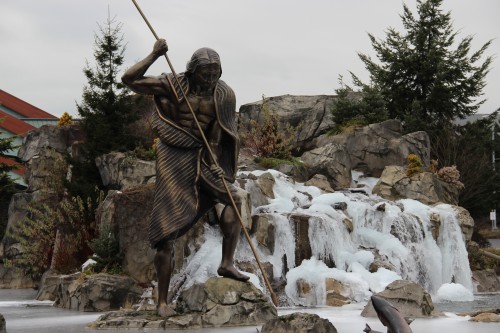
Andrew Gobin/Tulalip News
syəcəb
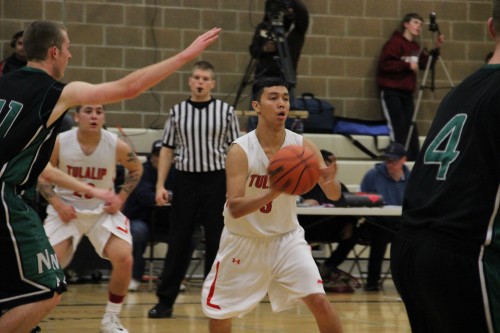
Heritage Boys set the bar high with season opener win
Article and photos by Andrew Gobin/Tulalip News
Tulalip − From warm up to the last point, Tulalip Heritage Hawks could not be stopped at the Northwest 1B season opener against Cedar Park Christian/Mountlake Terrace Lions, winning 64-50.
The Hawks flew into action, scoring first and maintaining a solid five point lead throughout the game, never slowing down, executing each play with precision. On the rebound or steal, the Hawks led the charge up and down the court.
Head coach Marlin Fryberg Jr. said, “This is a great start to the season. We played against this team last year three times and they beat us each time. In practice, the emphasis was to open the season real strong and show them and the other teams how Tulalip will play this year.
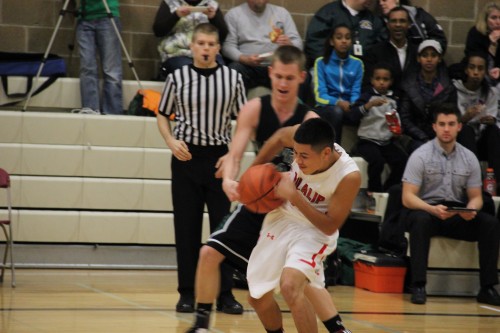
Dontae Jones, known for his quick feet, moved low and fast dodging many Lions players, flashing a smile as he breezed by. Brandon Jones and Shawn Sanchey with the rebound wasted no time getting to the hoop. All players proved to be strong shooters, with Payton Comenote sinking three pointers throughout the game.
The MVP of the evening, though, was sophomore Robert Miles Jr. He scored 24 points for the Hawks, with 16 rebounds and four steals.

Fryberg said, “All of our boys played a great game, but Robert was outstanding. As a sophomore, he plays basketball the way you would hope a senior would play.”
According to Fryberg, the goal this year is to return to the state championships, and to win.
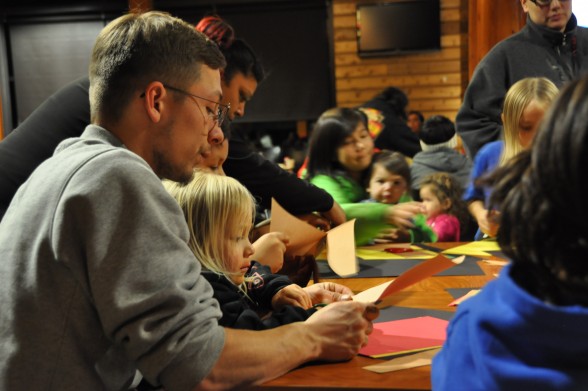
By Monica Brown, Tulalip News Writer
Lushootseed Family Nights are back for the next eight weeks and the language department is inviting anyone with the desire to learn the Lushootseed language to attend. This season’s first meeting took place at the Tulalip administration building on Wednesday, Nov 20th and was organized to gaing ideas from students for the upcoming activities and lessons.
“We call ourselves language warriors and anyone who comes to help out is a language warrior too,” said Natosha Gobin during Wednesday’s family night. Family night events have been taking place since the early 90’s and are gaining momentum as more children and adults become dedicated to learning the language.
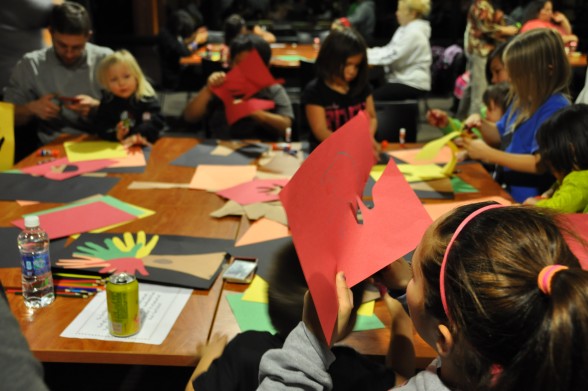
Lessons teach basic phrases, words, songs and prayers that can be used in everyday conversations. All lessons and materials are provided at no charge and are open to anyone interested in attending. At the first two meetings, dinner is provided by the department but the following meetings will be potluck dinners. Future Family Nights will be held at Tulalip Hibulb on Wednesdays from 5:00pm to 7:00pm, regular attendance is not required.
Fall Lushootseed Family Nights Schedule
November 20, 27
December 4, 11, 18
January 8, 15, 22, 29
Tulalip Hibulb Cultural Center is located at 6410 23rd Ave NE, Tulalip, WA 98271. For more information, please contact: Natosha Gobin ngobin@tulaliptribes-.gov 360-716-4499.
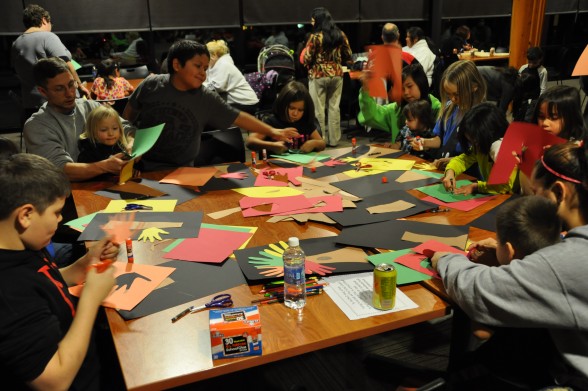

By Monica Brown, Tulalip News writer
TULALIP, Wa -Thanksgiving has come and gone and with that comes plans for holiday gift giving. As you think up your gift giving list and begin planning for Black Friday sales and bookmarking Cyber Monday deals these are great days to score that one gift, if you know what you are looking for and are able to get it. But, between Black Friday and Cyber Monday is Small Business Saturday, a day to shop local and support small businesses.
Along with having mainstream gifts, a majority of the small business shops will have that neat and perfect gift that that isn’t made in mass quantities and can only be found within a small business shop. The best part is, these small and local businesses support local artists and offer unique gift ideas that have been hand made.
Generally, the small business shopping districts are found in small towns and are located in the old part of town. If you decide to venture out the day after Black Friday to continue your pursuit for the perfect gift, a few local and semi-local towns have a good selection of shops.
Click town names to follow a link to the list of businesses within the area and directions to get there.
· For many years, Snohomish was known for their large antique district on First St. Even though it is mostly boutiques now; it still has plenty of antique shops and both have unique gift possibilities.
· First St. in La Conner has nearly everything in one condensed area, boutiques, odds and ends, antiques, local artists and hobby shops.
· In Anacortes, on Commercial Ave there are a few odds and ends shops with a good mix of antique shops.
· Pike St and the University District in Seattle have many various shops to suit all interests.
· Port Townsend has a large down town strip on Water St. with many small businesses that range from boutique and quirky items to local artistry.
· Near the ferry landing in Port Angeles on Font St and 1st St are hobby shops, odds and ends and local artistry.
· Although it is far and over Steven’s Pass, Leavenworth has a large downtown shopping area that has a variety of small business shops.

By Monica Brown, Tulalip News Writer
TULALIP, Wa – Tulalip’s Hibulb Cultural Center, on occasion, feature film screenings of films that star, are filmed by or are written by Native Americans, yet all tell one facet of the Native American life. Thursday, Oct 24th’s featured screenings were of Jeff Boice’s work with the Tulalip Tribes. Jeff Boice, a videographer/editor, has been working with the Tulalip Tribes since 1990, has also done video shootings for large media companies such as The Discovery Channel and CNN.
The evenings screening were many short segments of the Walking Tour II with Ray Moses, History Minutes and a Williams Shelton’s segment. The Walking Tour follows Tulalip tribal member Ray Moses as he tells stories about significant locations on the Tulalip reservation. “He’s quite a historian. It was great working with Ray,” commented Boice.
History Minutes are under a few minutes, are produced for the museum and focus on one particular aspect of tribal life such as boarding school life or construction of summer homes that were used in the old days.
The William Shelton segment centered on the portion of William’s life when he carved the Sklaletut pole, a culturally important piece of artwork. Boice has a genuine interest in documenting the past of the Tulalip Tribes and states, “Our hopes are that this video will help generate enough interest to be able to do a longer documentary [on William Shelton] but not just that but to generate interest in preserving the Sklaletut pole.”
Most screenings events at the Hibulb are relatively intimate, are under a few hours and include a Q and A afterwards. For more about future film screenings at the Hibulb please visit their website or call 360-716-2600. To view the works of Jeff Boice, visit Boicetv.com.

Andrew Gobin/Tulalip News
NEA recognizes Marysville schools’ turnaround
Article and photos by Andrew Gobin/Tulalip News
Tulalip − American Education Week began Monday, November 18th, with visits to Totem Middle School and Tulalip Quil Ceda Elementary school by the National Education Association (NEA) and Washington Education Association (WEA). Both campuses, earmarked as priority schools, exemplify a joint commitment of students and teachers to academic achievement. The incredible turn around embodies the intent of the School Improvement Grant (SIG grant) they received as schools in need. A change in national perspective led to the development of the grant which catalyzed the positive turn around at these schools.
“Because of previous legislation, schools that needed assistance were labeled failing,” said Kim Mead of the WEA, referring to No Child Left Behind, which decreased funding to schools that did not meet state and national standards. “We changed our perspective, failing schools came to be seen as priority schools.”
In the last five years, 97 Washington schools were considered failing and had their funding cut. With the new perspective of those schools as a priority, the US Department of Education created the SIG grant in 2010, providing three-year funding to schools on the national priority list. 28 schools were awarded grant funding of the 60 eligible schools in Washington state that applied.
The SIG grant is conditional funding, giving four plan options to bring schools up to standard. These options are closure and transfer students to high achieving schools, turnaround by reorganizing currents school curriculum and staff, transformation through a change in leadership and instruction, and restart which would convert public schools to charter schools, which were illegal in Washington state until 2012. Of the 28 Washington priority schools awarded grants, now specified as SIG schools, 1 school closed, 23 selected transformation, and 4 opted for the turnaround, including Totem, and Tulalip Quil Ceda.
Led by the teachers, these schools developed their staff and curriculum to change the professional practices in their schools. Through the SIG funding, Totem purchased laptops for each grade in order to assess individual understanding of course materials. They developed a home visit program so that teachers have the necessary skills to bring school needs into the home, while addressing home issues, not as a means lower standards or make accommodations, but to understand how to balance the school work with home life. The most prominent demonstration of home life coming to school is the morning assembly at Tulalip Quil Ceda, which incorporates traditional values into the school day. The NEA observed the assembly during their visit.
“I chose Washington to kick off American Education Week,” said Dennis Van Rockel, NEA president. “I hear so much about Washington, what you all are doing here, and I’m glad to be able to come and see it first hand.”
Programs in these SIG schools that see drastic positive improvement are leeching out into other schools throughout MarysvilleSchool District.
“This is important as we get ready to roll out the Common Core curriculum, which is the national standard equivalent,” said Tulalip Quil Ceda teacher, George Camper.
2013 marks the final year of the SIG grant funding, which means the priority schools were evaluated nationwide. Totem and Tulalip Quil Ceda not only outperformed all others in the state, they outperformed the nation’s priority schools. In recognition of their achievement, each of their libraries were given $500, and each school was given a banner acknowledging their accomplishment.
The nation is now looking to Washington as an example for the work Totem, and Tulalip Quil Ceda schools have done. They have set a standard for priority schools nationwide, which is described in a packet titled ‘Improving Student Achievement in High-Poverty Schools: Lessons from Washington State,’ that outlines how these schools successfully turned around from persistently low achieving to high achieving.